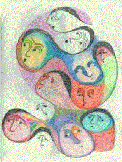While writing this poem scenes from Shakespeare
drifted on the whirling crescendi of the Sorcerer's Apprentice
ending with the concept embedded in the Greek myth of the adventurer
who flew too high too close to the sun - the name escapes me.
A narrative over view:
This poem makes use of archetypal structuring
in weaving its intellectual emotional and physical components
. It begins with primal fear - metaphors establish a boundary
separating the world of fear as over there.
It challenges the concept of immortality
pointing towards the possibility that there is no life after
death - that the conscious spirit does not live on. It resolves
this terror of nothingness when the skull finds its slate grave
- it belongs to a cycle of life - death and then life again.
The artist symbolized by Alison - also
a symbol of mother earth - living in a world of pure perception
adds death in the form of the ground up skull to her fiery life
colours and from her soul pours the water of life into the pigments.
Generating the tornado like trance of whirling spirit that rises
breaking free of worldly constraints
It ends with the grief of those left
behind - the grief of those too fearful to abandon the controls
of rules - rule by fear - rule by fear of intimidation - rule
by fear of shame - rule by fear of ridicule - rule by jealousy
hatred and anger - rule by fear of shunning
All these programmed social constraints
prevent us for setting our consciousness free to explore the
artistic world of pure perception. The poem ends in victory
for the free spirit and tragedy for those who cannot be set
free from their socializing constraints.
Keith




